There are 14 different species of turtles in West Virginia, of those, three are facing population declines, and one is a terrestrial turtle. Meaning it lives most or all of its life on land.
Turtles are a very important part of the ecosystem. Their eggs and young provide food to a variety of animals, and the adult turtles themselves help modify habitats. They graze and disperse seeds for native plants.
Some dig burrows that other animals use, and turtles are important mineral cyclers. Many other animals rely on these long lived, slow-moving reptiles.
In this article, we will go over all these important animals so you can identify them while you’re out exploring.
Table of Contents
Snapping Turtles in West Virginia
1. Common Snapping Turtle
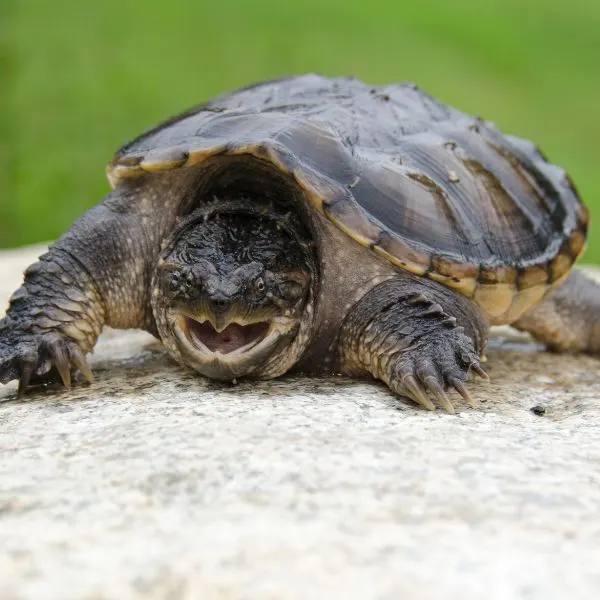
- Experience Level: Intermediate
- Family: Chelydridae
- Scientific Name: Chelydra serpentina
- Other Names: Snapping turtle, Eastern Snapper, Snapper
- Adult Size: 8 to 14 inches
- Lifespan: 30 to 50 years
- Average price range: Between $20 and $60
The Common Snapping turtle is a large, reclusive turtle that resides in many waterways, preferring ponds, lakes, and marshes with muddy bottoms. There they like to hide and wait for prey to swim by.
Common Snapping turtles are ambush predators. They will lay at the bottom of the water with their mouth open.
There they will wiggle a small worm-like projection on their tongue to attract fish and other aquatic creatures. When a tasty snack cruises by, they will shoot their long necks out, and “snap” it up with their extremely strong jaws.
The snapping turtle doesn’t like to leave the water unless they are looking for a proper nesting site. When attempting to find a place to deposit their eggs, they may travel over 10 miles to find soft dirt that is easy to dig in.
During the spring and summer months, you may come across snapping turtles on the road. This is where many meet their demise because they often get run over. Keep your eyes peeled while driving during these months.
For the most part, these big turtles are shy and prefer to be left alone. Once they are out of the water they feel exposed and can take on a hostile presence. They will hiss, open their mouths and try to bite if they are approached or handled out of the water.
Their jaws are very strong and can break fingers, and leave nasty wounds, so if you happen to see one out of the water, leave it alone and let it go about its business.
The Common Snapping turtle is an omnivore, eating anything it can fit into its jaws. They will even eat smaller turtles if they get too close.
Spotted Turtles in West Virginia
2. Spotted Turtle

- Experience Level: Intermediate to Expert
- Family: Emydidae
- Scientific Name: Clemmys guttata
- Other Names: Polka-dot turtle, “Spotty”
- Adult Size: 4 to 5 inches
- Lifespan: Males up to 65 years; females up to 110 years
- Average Price Range: $200 to $300
Spotted turtles are a semi-aquatic species. They spend some of their life on land, and part in the water. Because these turtles can only swallow in the water, they have to enter waterways to feed.
Spotted turtles are listed as endangered. Not only is habitat loss a problem, but these turtles are poached for the pet trade because they are so small, easy to handle, and very attractive.
These turtles like slow-moving and shallow water habitats such as marshes, wet meadows, swamps and bogs, and at shallow edges of lakes and ponds. They will hibernate in the water by burying themselves in the mud when winter sets in.
The Spotted turtle usually has a black carapace, with a contrasting, yellow, orange, or black plastron with a black pattern. They have spots along the top of their shells, while their limbs and head are colored similarly to the bottom of their shells.
Like most other turtles, the Spotted turtle is omnivorous. They will eat small insects, worms, and other invertebrates as well as some aquatic plants.
Wood Turtles in West Virginia
3. Wood Turtle
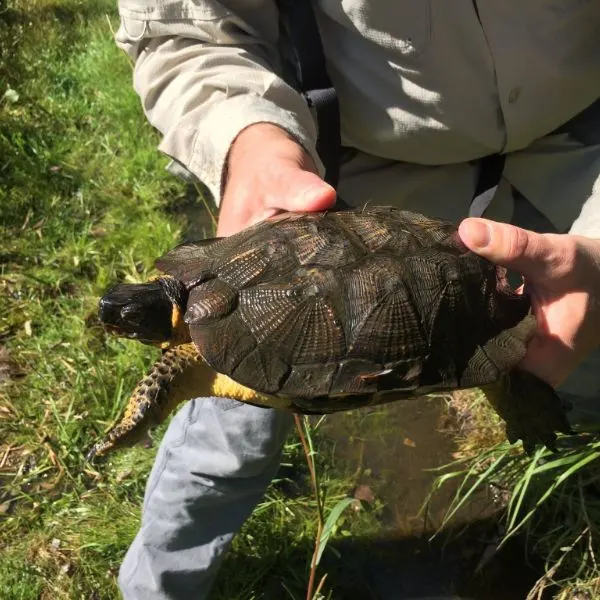
- Experience Level: Intermediate
- Family: Emydidae
- Scientific Name: Glyptemys insculpta
- Other Names: N/A
- Adult Size: 5.5 to 9 inches
- Lifespan: 40 to 60 years
- Average Price Range: $250 to $500
Another small, semi-terrestrial turtle, the Wood turtle is also endangered in West Virginia. Much like the Spotted turtle, habitat loss, and illegal pet trade activities are prime reasons this turtle is approaching dangerously low populations.
The wood turtle has a domed shell that flattens out around the edge. What makes it so unique looking is how the scutes take on a pyramidal shape, with pronounced ridges. This makes the turtle’s shell look like it was carved from wood—hence its name.
The top shell of the Wood turtle is usually dark brown or black, while the plastron is yellow with dark spots. The head is often black, while its limbs are typically orange or yellow with the occasional black spot.
Wood turtles like shallow clean waters surrounded by heavy woods. These little turtles will travel distances in the search of food. They eat nearly anything but prefer berries and worms.
The wood turtle has been observed doing something no other animal has done. They will stop their feet and shells in a type of dance called the “worm-stomp.”
The noise and vibrations resemble rainfall which sends worms out of the ground. They emerge to keep from drowning but end up getting gobbled up by the turtle.
Box Turtles in West Virginia
4. Eastern Box Turtle

- Experience Level: Beginner
- Family: Emydidae
- Scientific Name: Terrapene carolina carolina
- Other Names: Land Turtle
- Adult Size: 4 to 7 inches
- Lifespan: 50 to 100 years
- Average Price Range: $260 – $360
The Eastern Box turtle is a terrestrial turtle that prefers moist forests, marshes, and grasslands. Though they are often found in mountainous regions, they don’t like steep ridges and hillsides.
These turtles have a high domed shell that is dark green to black with orange, red, or yellow patterns on their scutes and the rest of their body. This turtle has a hinged shell that it can retract into and completely close itself inside. They do this to protect themselves from predators.
The Easter Box turtle is listed as vulnerable. They can live for a very long time and take many years to become sexually active. This is one of the reasons this animal is facing dwindling populations.
When adults are taken from the wild, it takes many years for juveniles to start mating to replace the taken populations.
Eastern Box turtles can live over 100 years, but in captivity, they typically live between 20 to 60 years.
When these turtles are taken from the wild and contained as pets, they get extremely stressed. They often won’t eat and will suffer from health problems and a shortened lifespan.
These turtles are omnivores and will eat nearly anything they come across. Box turtles will eat worms, mollusks, insects, plants, eggs, and carrion.
Map Turtles in West Virginia
5. Northern Map Turtle
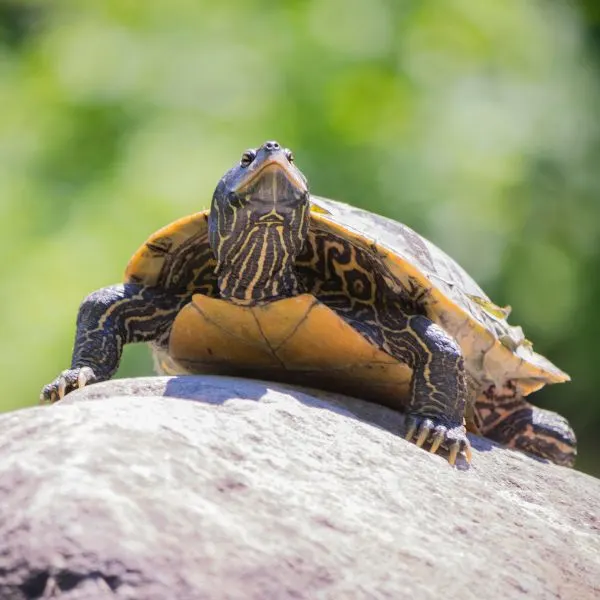
- Experience Level: Beginner
- Family: Emydidae
- Scientific Name: Graptemys geographica
- Other Name: Common map turtle
- Adult Size: Between 4 and 10 ½ inches
- Lifespan: 15 to 20 years
- Average price range: Between $20 and $60
The Northern Map turtle or Common Map turtle is one of 14 different species of map turtles. They get their names from the light colored contours on their scutes when young that resemble the contours of a map. As these turtles get older, these distinctions tend to fade.
The Common Map turtle has a flattened shell that is dark brown or black. When they are young they have saw-toothed ridges on the top, and center of their shells, but as they mature, these ridges smooth out.
Their skin is highly striped by light-colored streaks, and their plastrons are often yellow, cream, or another lighter color.
Males of this species only grow about half the size of females. While female map turtles can get as large as 10 inches from shell tip to tip, the males only grow to about 5 or 6 inches in length.
Stagnant, slow-moving waters with plenty of vegetation are areas that attract the Common Map turtle. While they spend a lot of time swimming around these waters, they also like to crowd floating logs, or edges of the water when basking.
Northern Map turtles are omnivores. They will eat amphibians, fish—dead or alive—crayfish, mollusks, insects, plants, and fruits.
6. Ouachita Map Turtle
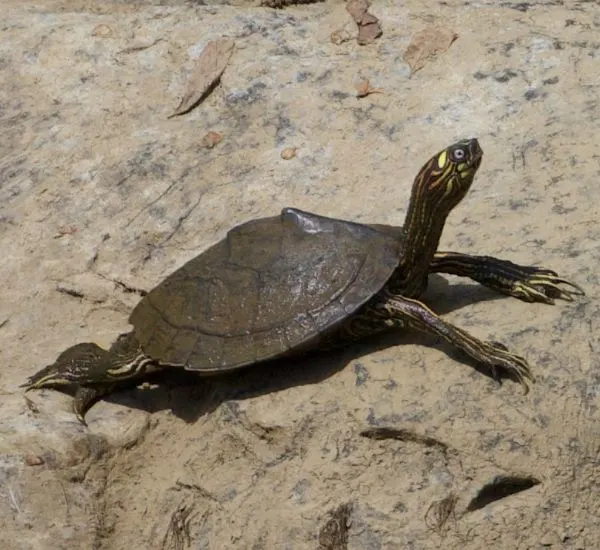
- Experience Level: Beginner
- Family: Emydidae
- Scientific Name: Graptemys ouachitensis
- Other Names: Southern Map turtle
- Adult Size: 3.5 to 10 inches (9 to 25.5 cm)
- Lifespan: 15 to 20 years
- Average Price Range: $40 to $100
The Ouachita Map turtle is a turtle with great numbers and is listed as one of least concern. They are able to reproduce in large numbers and do so multiple times per breeding season.
Ouachita Map turtles are very similar to the Northern Map turtle in appearance, habitat, and diet. In fact, these turtles are often mistaken for one another.
To tell the difference takes a keen eye, and lots of experience with turtles, map turtles in particular. One of the main differences between the Ouachita and the Northern Map turtle is the markings on their heads.
The Northern Map turtle often has thin stripes running along the top of their heads, while the Ouachita Map turtle has fewer stripes and a pair of thick white spots on the top. The Ouachita map turtle tends to keep a prominent keel along the back of its shell.
Painted Turtles in West Virginia
7. Eastern Painted Turtle
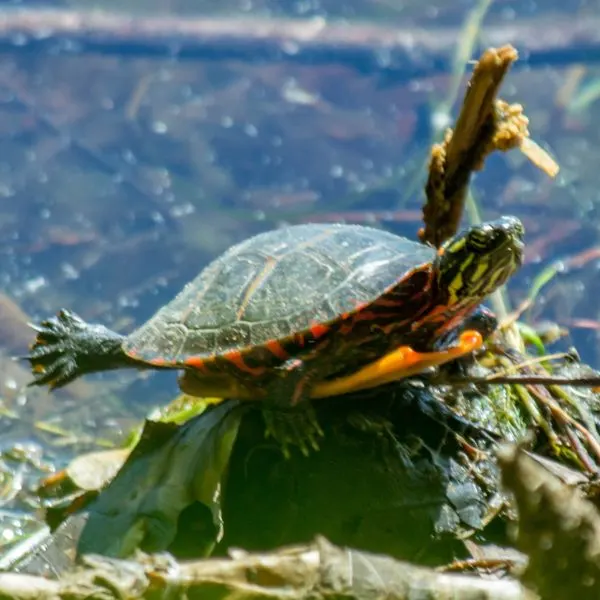
- Experience Level: Beginner
- Family: Emydidae
- Scientific Name: Chrysemys picta picta
- Other Names: N/A
- Adult Size: Between 5 and 7 inches
- Lifespan: Between 30 and 50 years
- Average price range: Between $30 and $150
Painted turtles are some of the most prolific and widespread turtles in the United States. There are four separate subspecies with the Eastern Painted turtle and Midland Painted turtle found in West Virginia.
The Eastern Painted turtle has a slightly domed carapace that ranges from dark green to black, with yellow stripes. The plastron is brighter colored from red to yellow. Their heads and limbs have plentiful stripes running along the skin.
Painted turtles like slow-moving and shallow bodies of water. Ponds, bogs, and shallow lakes with lots of aquatic vegetation are where you’ll find these turtles.
Often you will see these turtles crowding fallen trees, rocks, sandbars, or the shore when basking in the sun. They may even come out of the water and bask during warm, sunny, winter days.
Painted turtles are omnivores. They will eat insects, fish, amphibians, snails, and underwater vegetation.
8. Midland Painted Turtle

- Experience Level: Beginner
- Family: Emydidae
- Scientific Name: Chrysemys picta marginata
- Other Names: N/A
- Adult Size: Between 4 and 10 inches
- Lifespan: Between 30 and 50 years
- Average price range: Between $30 and $150
The Midland Painted turtle is difficult to distinguish from the other painted turtle species. One way to distinguish them is to turn the turtle over and examine the plastron. Midland Painted turtles have black, shadowy markings running along the middle of the shell.
The carapace of Midland Painted turtles is black or brown, and their skin has stripes that start out yellow at the front of the head, and often darken to red as they get closer to the shell.
The Midland Painted turtle enjoys the same habitats as the Eastern Painted turtle, and they both eat the same things.
These turtles start digging nests and laying eggs in soft soil between May and June. After 80 days the eggs hatch and tiny baby painted turtles emerge in late summer and early fall.
Pond Sliders in West Virginia
9. Red Eared Slider

- Experience Level: Beginner
- Family: Emydidae
- Scientific Name: Trachemys scripta elegans
- Other Names: Red-eared Terrapins, Red-eared slider turtle, Slider turtle, and Water Slider turtle
- Size: 7 to 11 inches
- Lifespan: 30 to 40 years
- Average Price Range: $20 to $100
The Red Eared slider is one of the most popular pets and prolific turtles across the United States. Unfortunately because of their popularity, this turtle is found in many non-native habitats where they become a nuisance and invasive pests.
Turtles can live for many decades. This longevity is something some turtle owners don’t truly comprehend because turtles and tortoises can often outlive their owners. When this happens concerned family members can mistakenly set them free in the wild.
While the intentions are innocent and good-willed, it’s really not the best way to deal with wildlife. The pets can become invasive species and threaten native numbers, or in worst case scenarios, the pets don’t know how to fend for themselves and end up dying.
The Red Eared slider has a dark colored carapace with bright markings all over it. It has yellow stripes along its skin, and distinctive red patches behind the eyes that look like ears.
You can often find these turtles in nearly any kind of water, but they prefer ponds, lakes, and warm watered creeks.
Most things are on the menu for the Red Eared slider as they are omnivores. They will eat meat, fish, aquatic animals, plants, and occasionally fruits.
Cooters in West Virginia
10. Eastern River Cooter

- Experience Level: Beginner to Intermediate
- Family: Emydidae
- Scientific Name: Pseudemys concinna concinna
- Other Names: River Cooter
- Adult Size: Between 8 and 12 inches
- Lifespan: Between 20 and 40 years
- Average Price Range: $20 to $50
A naturally shy and reclusive turtle, the Eastern River cooter spends most of the time either submerged underwater or basking in the sun. When they notice anything bigger than they are, they typically slide into the water very quickly.
This turtle can hold their breath for a long time underwater. They can absorb oxygen through their skin, through buccal pumping, and can even absorb oxygen through their cloaca. These adaptations can let them stay underwater for hours at a time.
The Eastern River Cooter looks very similar to Red Eared sliders. The main difference is the red “ears” that are absent in the Cooter.
Eastern River Cooters prefer to live in areas of flowing waters such as swift moving lakes, rivers, and streams, but they can be found in most bodies of water with a lot of vegetation.
Most turtles, especially aquatic turtles, are generally omnivores that consume a meat heavy diet. The Easter River Cooter is quite the opposite. Nearly 95% of its diet consists of algae and vegetation.
They can spend hours underwater grazing on various plant matter.
11. Northern Red-bellied Cooter
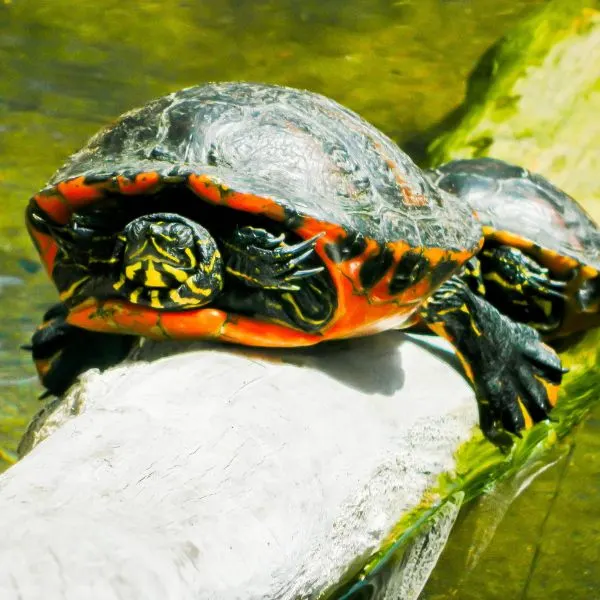
- Experience Level: Beginner to Intermediate
- Family: Emydidae
- Scientific Name: Pseudemys rubriventris
- Other Names: American red-bellied turtle
- Adult Size: Between 8 and 12 inches
- Lifespan: Between 40 and 55 years
- Average Price Range: Between $30 and $170
The Northern Red Bellied Cooter is a threatened species. Because of habitat loss, predation on eggs and juveniles, and severe competition by non-native turtles this species is listed as threatened or endangered, depending on the state.
The Northern Red Bellied Cooter is a medium to large sized turtle. Females can reach up to 12 inches in length, while males are smaller at maturation.
Adults have brown or black upper shells with reddish markings. The plastrons on these turtles are red or pink depending on age and sex, and they all have mottled marking on the underneath of their shell.
The shells of these turtles are not hinged, and the bottom is much smaller than the carapace. The plastron is only connected at the sides. Their front and back legs are free from restricting shell connections.
The Northern Red Bellied turtle has black skin with yellow or ivory colored stripes. As they age, these stripes begin to fade, leaving the turtles to look more blackened as they get older.
These turtles love to bask in the sun, but will quickly slip into the water at the slightest disturbances.
Though omnivorous, it’s the baby and juvenile turtles that eat more meat and insects than the adults. As they get older, the Red Bellied turtle takes on a more herbivorous diet. They mostly eat algae and other vegetation, but will occasionally still eat snails, crayfish, fish, and insects.
Musk Turtles in West Virginia
12. Eastern Musk Turtle
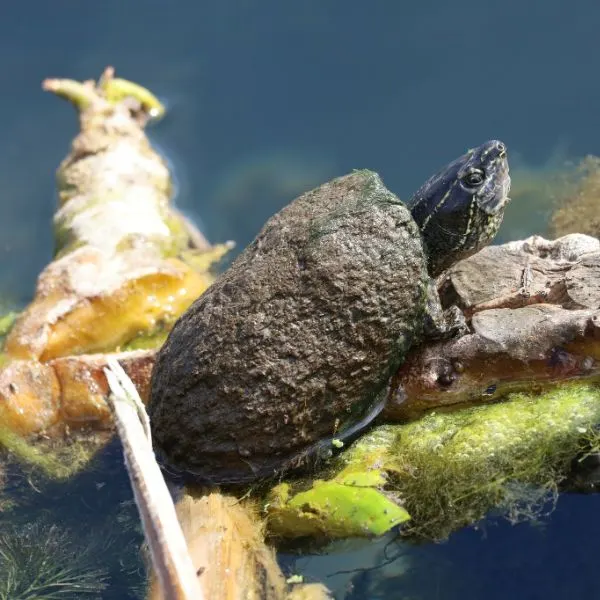
- Experience Level: Intermediate
- Family: Kinosternidae
- Scientific Name: Sternotherus Odoratus
- Other Names: Stinkpot, Common Musk Turtle
- Adult Size: Between 4 and 5 inches
- Lifespan: 50 years and over
- Average Price Range: Between $20 and $90
The Common Musk turtle is a popular pet among turtle lovers due to its small size and ease of care. Though it may take some time to get them used to you. If they feel threatened they will scratch, may try to bite, and will often release a sulfurous odor from their scent glands.
This foul, nasal assault is why they are often affectionately called the “Stinkpot.” These turtles are small, even when fully grown, and they have many predators in their formative years, so to protect themselves they can release a stinky stench.
The Common Musk turtle is rather drab colored. Their shell and skin are darkly colored and plain aside from a few light stripes on its head.
These turtles prefer slow moving, shallow waters with tall vegetation. Though they are mainly aquatic, they aren’t great swimmers. Sometimes they use the thick vegetation to climb up to get oxygen.
Musk turtles are omnivores that like to eat crayfish, snails, tadpoles, dead fish, seeds, and plants.
Softshell Turtles in West Virginia
13. Eastern Spiny Softshell Turtle
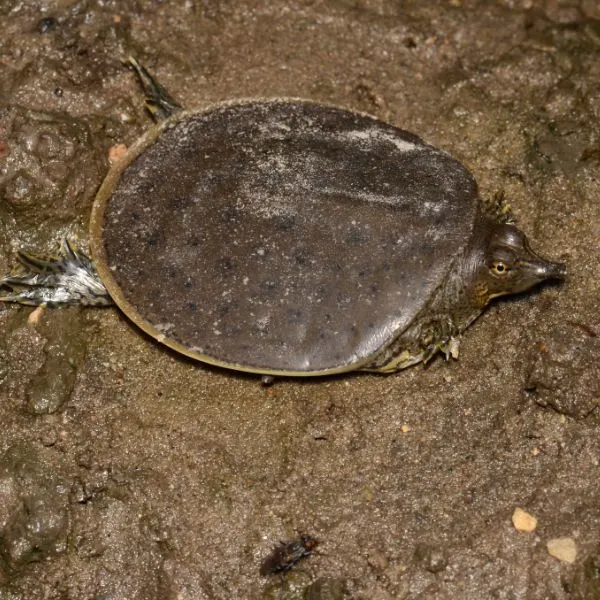
- Experience Level: Intermediate to Expert
- Family: Trionychidae
- Scientific Name: Apalone spinifera
- Other Names: N/A
- Adult Size: 5 to 9 ½ inches for males, 10 to 20 inches for females
- Lifespan: Between 20 and 50 years
- Average Price Range: Between $20 and $120
Eastern Spiny Softshell turtles are known for their flat, leather shells and long, snorkel-like snouts. They have a ridge of spiny or blunted nubs across the front ridge of their shells. Their shells are soft and feel a little like sandpaper.
These turtles are accomplished swimmers and are actually pretty swift on the ground. I’m sure in the tale of the Tortoise and the Hare, the tortoise in the story was actually a spiny softshell turtle because they are fast!
Spiny softshell turtles like to bury themselves in the sandy or muddy bottoms and ambush prey as it swims past. They will eat nearly anything that they can fit into their sharp jaws.
Their necks are very long and combined with the long snout, they will reach up to the surface without coming out of their hiding place to get a breath of air.
At full length, the Spiny Softshell turtle is the second biggest freshwater turtle in the United States. The winner for the largest turtle is the alligator snapping turtle.
Spiny softshell turtles are rather bland looking when it comes to coloration. They are tan, green, or light brown throughout most of their body. Black spots or blotches adorn the carapace of some spiny softshell turtles.
These accomplished swimmers prefer fast-moving waters of rivers, lakes, and streams.
14. Smooth Softshell Turtle
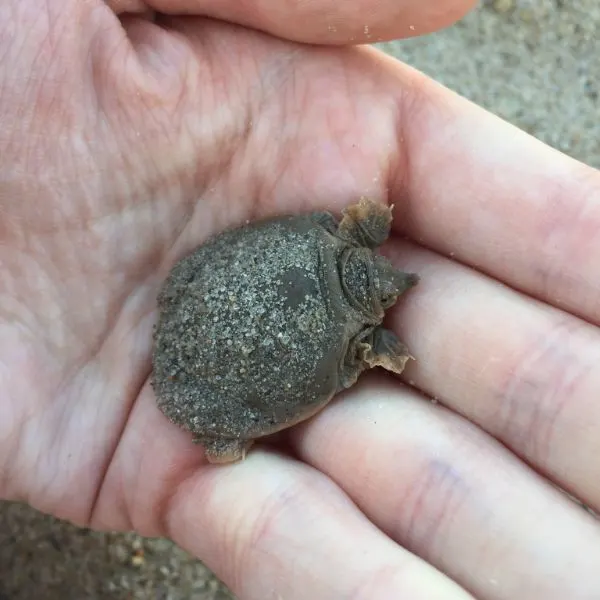
- Experience Level: Intermediate to Expert
- Family: Trionychidae
- Scientific Name: Apalone mutica
- Other Names: Spineless Softshell
- Adult Size: 4.5 to 14 inches
- Lifespan: 25+ years
- Average Price Range: $40 to $60
The Smooth Softshell turtle is often mistaken for the spiny softshell turtle and vice versa. They both have large, flat, leathery shells. The main difference is the absence of the spines or nubs in the Smooth Softshell. In recent years, the number of these species has decreased due to water pollution and channelization.
Both the Smooth and Spiny Softshell turtle can display aggressive behavior out of the water. Their soft carapaces offer little in the way of protection and they know it. So, make up for that by hissing, scratching with their dangerous claws, and biting with their sharp, strong jaws.
Smooth Softshell turtles are omnivores but they eat more meat than vegetation. They will eat fish, amphibians, insects, and even small mammals and the occasional small waterfowl when the situation presents itself.
While the spiny softshell turtle seems to be doing well, in some places the Smooth Softshell turtle populations are in decline. In West Virginia these turtles are listed as least concern, their populations seem to be very stable in the Mountain State.
Wrapping up
We hope this has helped you understand the turtles you may come across in West Virginia. Like all wildlife, when you see these amazing reptiles, it’s best to just observe from a distance. If any of these turtles sound like an animal you would love to have as a pet, we encourage you to not take them from the wild.
Look for turtle adoption agencies near you. Often you can find animals that need forever homes that are looking for attentive owners like you.
If there are no adoption, or rescue agencies in your area, look for reputable, registered breeders. They should be knowledgeable about the pets they are selling, and their animals should be free from illness and injury.
Be sure to understand that owning a turtle or tortoise is a lifetime commitment. Unlike cats and dogs that may live for 15 to 20 years, turtles can live for many more decades.
That’s it for Turtles In West Virginia. We would love to hear from you, so please leave us a comment about turtles you have seen or pets that you have.
Other nearby states
